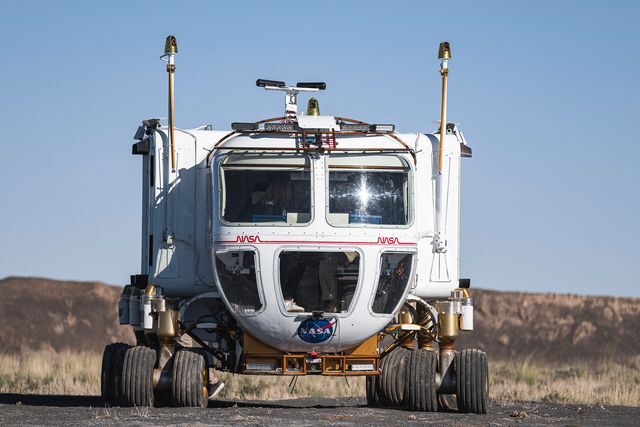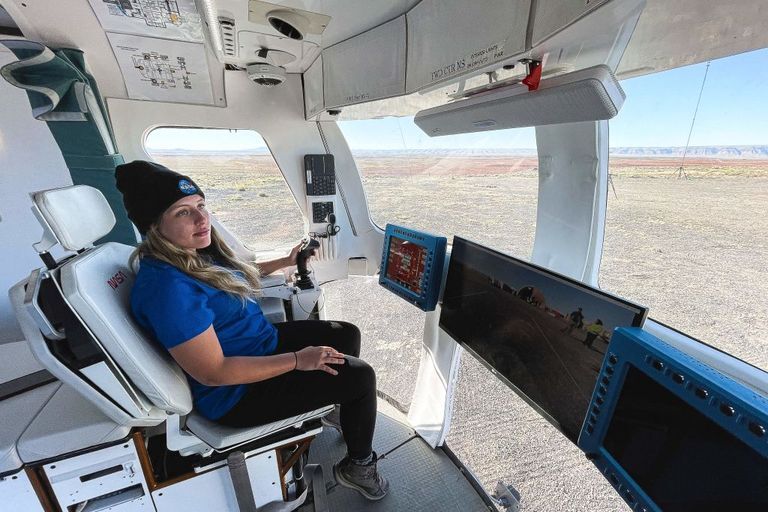3.12.2022
American and Japanese astronauts recently tested the prototype rover with a three-day trip in the Arizona desert. #spacevanlife

The Artemis mission is aiming to put astronauts back on the moon, but first, they’ll need a rover to camp around in. NASA teamed up with the Japan Aerospace Exploration Agency (JAXA) to test a prototype design for a pressurized lunar rover in the Northern Arizona desert in October, all part of a plan to have the rover ready for Artemis VII in 2030.
The testing was led by NASA’s Desert Research and Technology Studies (Desert RATS) program, which tests technology at the Black Point Lava Flow near SP Crater. The researchers focused on “conducting pressurized rover operations,” a key element of future Artemis missions.
“The Arizona desert possesses many characteristics that are analogous to a lunar environment, including challenging terrain, interesting geology, and minimal communications infrastructure,” NASA says, “all of which astronauts will experience near the lunar South Pole during Artemis missions.”

From October 11 to 22, three crews of two—two astronauts and a JAXA expert from Japan and two astronauts and an engineer from NASA—rotated through living and operating out of the pressurized rover for three-day stints, including conducting simulated moonwalks. The mission was meant to gather data about the rover’s design, cabin configuration, driving modes, timeline constraints, and mission operations to support potential design concepts for future pressurized rovers.
The design requires that astronauts can live and work comfortably inside the rover for and extended period of time, while periodically exiting the vehicle to collect samples or conduct experiments. The pressurized rover will function as a mini base for the astronauts to live in while away from the permanent lunar base camp that NASA is planning to build. There’s also another, smaller rover being designed for the Artemis mission, which NASA has dubbed the “lunar terrain vehicle,” to make it even easier to travel around the surface of the moon—but it isn’t pressurized.
“Pressurized rovers are like recreational vehicles,” NASA says, “safely housing astronauts for weeks at a time, complete with all the air, water, food, hygiene equipment, and tools they need on their trek across the lunar surface.”

The Northern Arizona site has served as a simulation of the moon ever since Apollo testing in the 1960s. The lava-like rock composition and stark landscape make it the perfect training ground for the conditions astronauts will face on the moon.
For the pressurized lunar rover prototype, designers needed to learn how to keep the astronauts warm and the electronics cool, all while allowing astronauts to live and work inside. The rover needs to have self-sufficient energy sources, relying on solar power to recharge an onboard battery. With an expected lifespan of 10 years, engineers must determine the best set-up for batteries and charging capabilities.

The team created different scenarios to put the rover’s power supply through its paces to “see which one of those puts the hardest design constraint on the vehicle and then design around that,” Jim Free, associate administrator for exploration systems development at NASA, tells PBS.
The prototype design featured a windowed front of the van-like vehicle with six independently operating wheels, which allows the vehicle to sidestep rocks like a moonwalking crab or spin in tight circles. The pilot operates the rover with a joystick. It also has the ability to drive on its own to keep up with astronauts who have exited the rover to run experiments.

The United States is working with Japan, which may end up being the agency responsible for providing the pressurized lunar rover, and is expecting to have a final design by 2023. The design can then be sent to a contractor for creation.
Marc Reagan, Desert RATS program mission manager, tells PBS, “I think we’re building an excellent product that the American people will be proud of.”
Quelle: POPULAR MECHANICS
